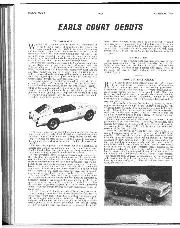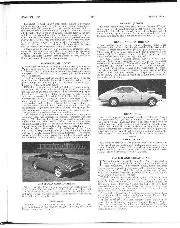

Earls Court debuts
TRIUMPH GT6 WHEN the Triumph Spitfire Four was announced it seemed only a matter of time before the Vitesse Six engine was dropped in. Well, it was a long time…
BRITAINS GREAT COME BACK at LE MANS
On the face of it, the fact that the two Lagondas
nished third and fourth in the Grand Prix d’Endurance at Le Mans last month does not seem much to write home about. A cynic would ask : Why didn’t they win ?
But let us consider the circumstances. The cars were making their racing debut, and they had yet to show that they possessed the all-important virtue of stamina. All the world knew that they were the work of Mr. W. 0. Bentley, whose products have won at Le Mans on five occasions in the past, and they therefore carried with them the burden of a great reputation. And finally, the company had announced that they regarded the race as an experiment from which to draw the fullest possible lessons about the cars with a view to participation in future sports-car races at Le Mans and elsewhere. Bearing these circumstances in mind, it will be seen that the performance of the two cars was even better than had been anticipated. Aiming at finishing, above all else, it would have been quite satisfactory if had finished fifth and
sixth, or even seventh and eighth. Instead of that, they actually finished third and fourth, both cars averaging a higher speed than last year’s winner. It was obvious that the cars were running to a definite schedule, with a reserve of
engine revolutions. They might have averaged a still higher speed, but at Le Mans the race is not always to the swift—as witness the downfall of the meteoric Delage and the success of the plodding Bugatti. Far better it was that they should still be running well at the end, in third and fourth places, than that they momentarily dazzle the crowd with their speeds.
It must not be forgotten, too, that they finished first and second in the 5-litre class, in opposition to eight 31-litre Delahayes, three 4-litre Darracqs and three 4A-litre cars of that make.
A possible criticism of the cars—but a doubleedged one—is that they are perhaps a little clumsy through having a long wheelbase. On a short twisty, circuit like Donington, where it is hoped that the cars will run in the Tourist Trophy, this would indeed be a handicap, but at Le Mans it did not matter very much. On the other hand, if one regards the competing cars as basically standard types, there is no doubt as to which would carry the more comfortable coachwork, the Lagonda or some of its French rivals. A way out of this difficulty would be to produce an ultra-short wheelbase model for two-seater coachwork only, and to use this as the racing type. In shorter races where fast cornering is essential its greater controllability would undoubtedly be an asset, rest, the warmth of the appluase which the cars at the end For the cars was a sure indication of the impression the big green cars had made on the discrim
Mating Le Mans crowd. To Mr. Alan Goode, there fore, the thanks of Britain are due for giving one of our greatest automobile designers a chance to race his products in the most impor taut event of its type on the
International Calendar. As for ” W.0.” himself, nothing we can say could make him more content than he was as he stood in the courtyard of the Hotel Moderne, while mechanics put the finishing touches to the workManlike green cars which represented Britain so worth
ily in race.